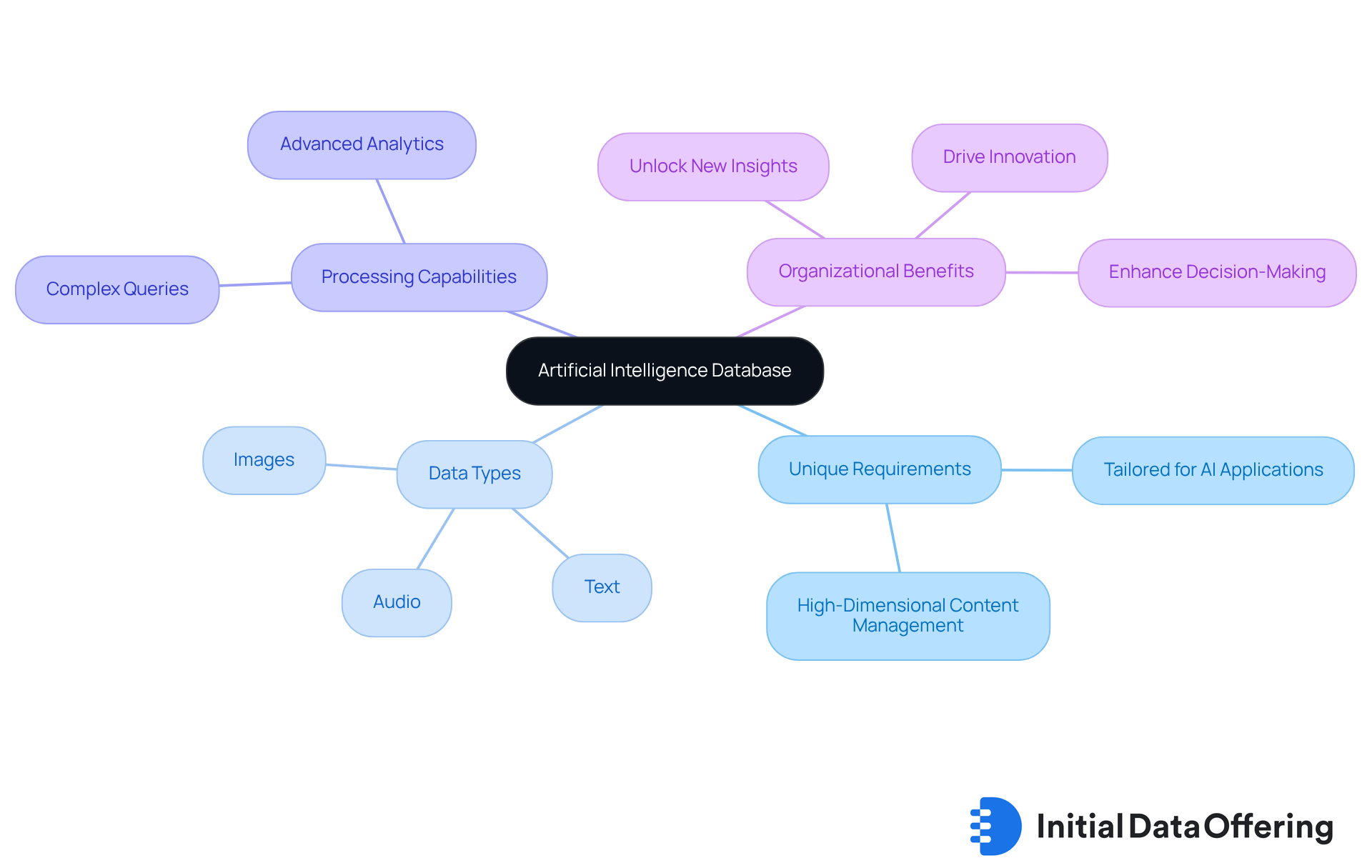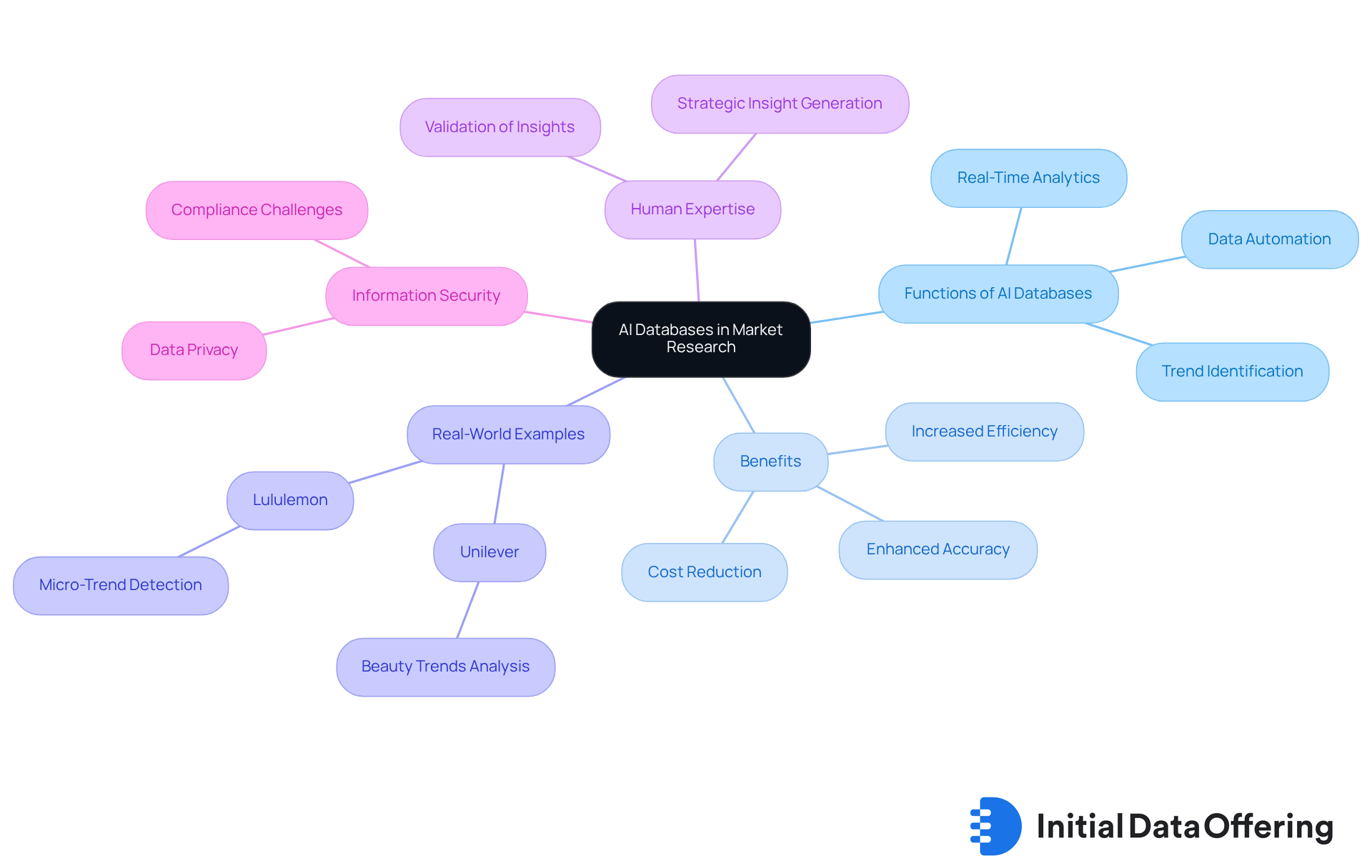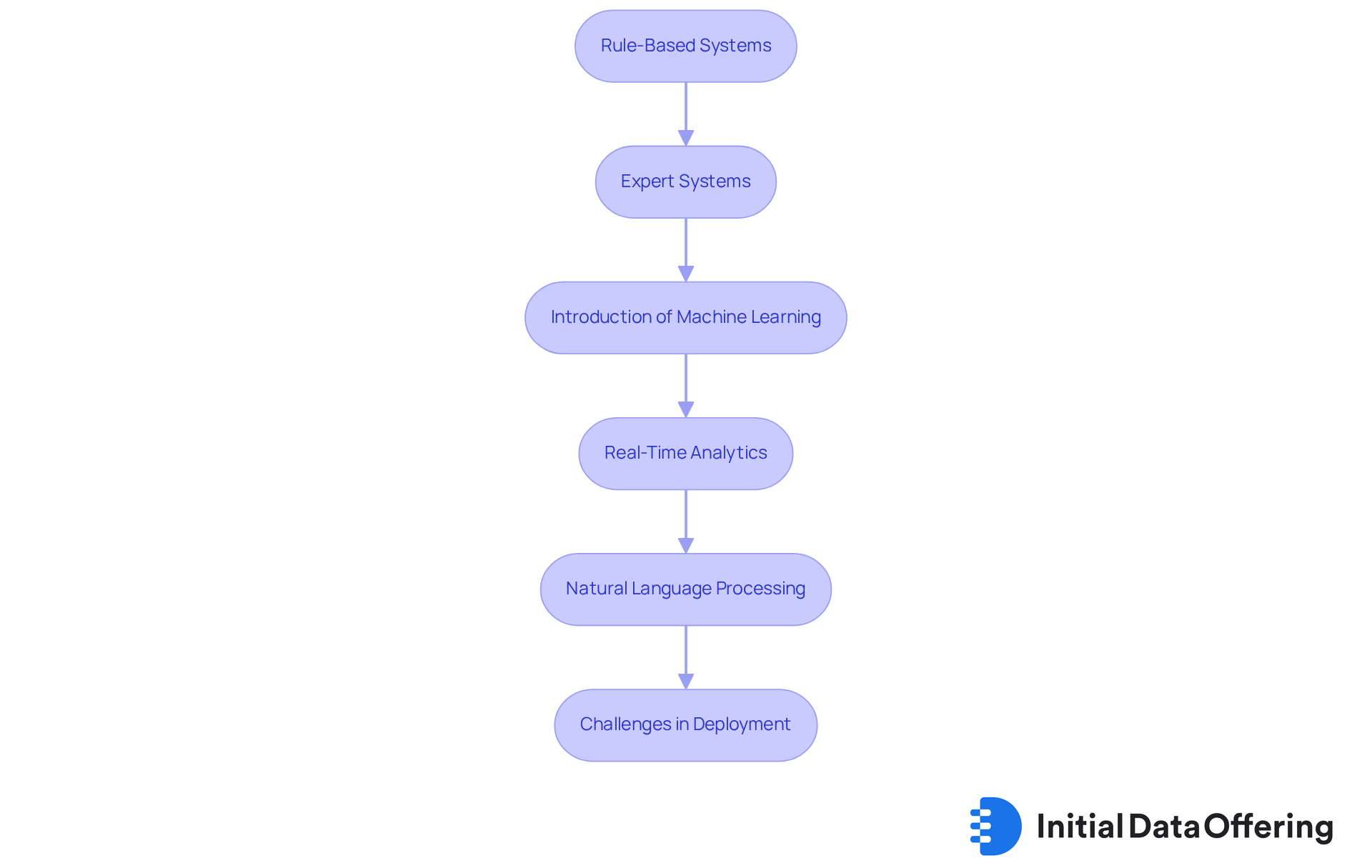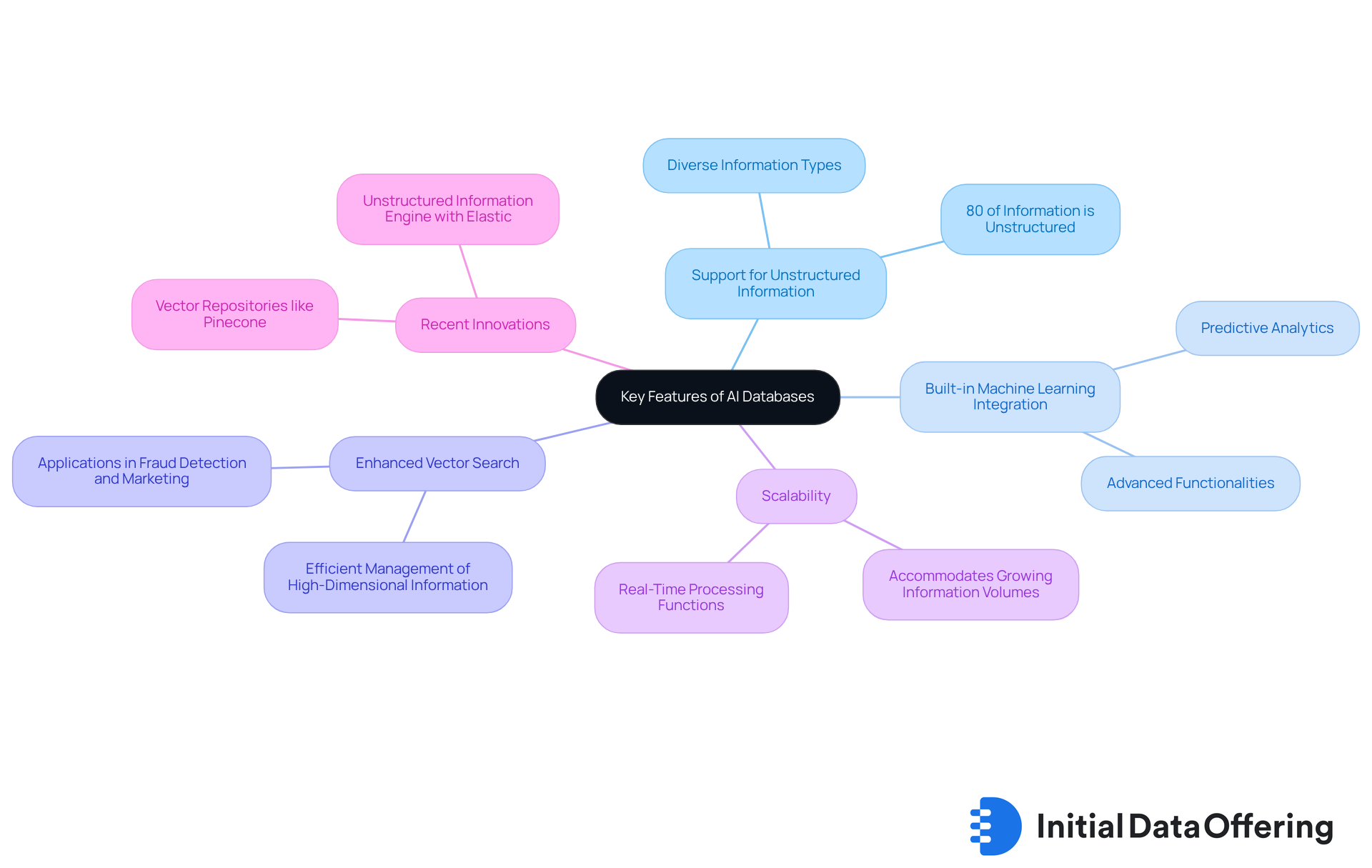Understanding the Artificial Intelligence Database: Key Features and Evolution

Understanding the Artificial Intelligence Database: Key Features and Evolution
Overview
This article explores the key features and evolution of artificial intelligence databases, emphasizing their crucial role in managing unstructured data and supporting AI applications, including machine learning. One notable feature is the advancement in vector search capabilities, which allows for more efficient data retrieval. Additionally, real-time analytics enhances the ability to make informed decisions promptly. These advantages are transforming data management practices across various sectors. As a result, organizations can drive innovation and gain a competitive advantage in the marketplace.
How can these advancements be integrated into your current data management strategies to maximize their benefits?
Introduction
Artificial intelligence databases are revolutionizing the way organizations manage and analyze data. These databases move beyond traditional systems to accommodate the complexities of unstructured information. By harnessing advanced analytics and machine learning capabilities, they empower businesses to extract valuable insights and drive informed decision-making.
However, as the landscape of AI continues to evolve, organizations must consider how to effectively leverage these databases. How can they not only keep pace with innovation but also gain a competitive edge in their respective markets? This question invites further exploration into the strategic implications of AI database utilization.
Define Artificial Intelligence Database
An artificial intelligence database functions as a specialized information management system tailored to fulfill the unique requirements of AI applications, including machine learning (ML) and large language models (LLMs). Unlike traditional systems that primarily manage structured data, an artificial intelligence database is specifically engineered for high-dimensional content. They excel in processing unstructured formats, including text, images, and audio. This unique capability not only supports complex queries but also enables advanced analytics, making the artificial intelligence database vital for contemporary AI-driven applications.
How can an AI Database transform your approach to data management? By leveraging its features, organizations can unlock new insights and efficiencies. For instance, the ability to handle diverse data types allows for richer analysis, leading to more informed decision-making. As AI continues to evolve, the importance of the artificial intelligence database will only grow, underscoring its role in driving innovation and competitive advantage in various sectors.

Contextualize AI Databases in Market Research
In the field of market research, the artificial intelligence database serves as an essential tool that facilitates the gathering, storage, and examination of extensive information. These systems empower researchers to swiftly identify trends, consumer behaviors, and market dynamics through advanced analytics and machine learning algorithms. For example, companies like Unilever leverage AI to analyze beauty trends, gaining a 6-12 month lead on consumer preferences. Similarly, Lululemon uses AI to detect micro-trends in real-time, enabling the creation of limited-run products that resonate with consumer interests.
An artificial intelligence database can automate the extraction of information from diverse sources, allowing researchers to focus on interpreting outcomes rather than engaging in manual data entry. This efficiency not only accelerates the research process but also enhances the precision of insights derived from the information. Notably, statistics reveal that nearly 89% of researchers regularly utilize AI tools, highlighting the increasing reliance on these technologies to bolster market research capabilities.
However, it is crucial to acknowledge that while AI acts as a catalyst for change, human expertise remains indispensable for validating information and concentrating on strategic insight generation. As Ray Poynter aptly states, "AI will not replace researchers, but it will redefine their roles. By automating repetitive tasks, researchers can focus on strategic insight generation." Furthermore, as organizations integrate AI systems, they must prioritize information security and compliance to navigate the challenges of today's digital landscape. By transforming raw data into actionable narratives, an artificial intelligence database ultimately fosters informed decision-making and strategic planning.

Trace the Evolution of AI Databases
The development of AI information systems can be traced back to the early stages of artificial intelligence research, which primarily focused on rule-based and expert systems. As computational capabilities advanced and the volume of information expanded, the necessity for more sophisticated management solutions became evident. The 1990s heralded a transformative era with the introduction of machine learning algorithms, enabling systems to learn from patterns and enhance their performance over time. This period marked the beginning of a new paradigm in information management, where systems could adapt and improve based on user interactions and emerging trends.
Since that time, AI systems have undergone remarkable advancements, incorporating features such as real-time analytics, natural language processing (NLP), and the ability to manage unstructured information. These innovations have made the artificial intelligence database indispensable across various sectors, including finance, healthcare, and marketing. For example, organizations like HSBC utilize machine learning to analyze millions of transactions daily, identifying potential fraud that static rules may overlook. As Spencer Kimball, CEO of Cockroach Labs, aptly noted, 'AI is foolish without access to quality information,' underscoring the critical importance of high-quality information in AI applications. Furthermore, the integration of NLP has expanded access to information, allowing non-technical users to query complex datasets in natural language, thus removing barriers to information utilization.
Statistics reveal that 42% of enterprises report that more than half of their AI projects have faced delays or failures due to inadequate information preparedness, emphasizing the vital role of quality information in the successful implementation of AI initiatives. Organizations also face challenges when deploying AI in information storage systems, such as integrating with legacy systems and consolidating fragmented data. As AI continues to progress, the emphasis on developing explainable and compliant AI pipelines remains a significant challenge, necessitating modernized infrastructure and cross-functional collaboration. Overall, the evolution of AI information systems reflects a continuous effort to enhance intelligence, accessibility, and responsiveness, shaping the future landscape of information management.

Identify Key Features of AI Databases
Artificial intelligence databases are characterized by several key attributes that enhance their functionality and integration with AI applications. Notably, they provide native support for unstructured information, which is crucial given that approximately 80% of the information generated today is unstructured. This capability allows organizations to leverage diverse information types, facilitating seamless integration with applications and artificial intelligence databases. Additionally, many AI databases feature built-in machine learning model integration, empowering users to implement predictive analytics and other advanced functionalities directly within the database environment.
Another significant advantage is the enhanced vector search capabilities, which enable efficient management of high-dimensional information. This feature is vital for applications such as fraud detection and personalized marketing, where intricate queries are necessary to extract actionable insights. Recent advancements in AI storage technology, exemplified by the introduction of vector repositories like Pinecone—recognized as the sole vector repository in the inaugural Fortune 2023 50 AI Innovator list—have revolutionized how organizations manage and analyze information, making it easier to identify significant patterns and trends.
The scalability of AI systems ensures they can accommodate growing information volumes while providing real-time processing functions for timely analytics. This combination of attributes positions AI information systems as essential tools for companies aiming to harness the full potential of their resources in an increasingly analytics-driven environment. Furthermore, innovations such as the new unstructured information engine developed in partnership with Elastic for the Dell AI System enhance vector and semantic search functionalities, further solidifying the role of artificial intelligence databases in modern information management. Expert insights, including those from Ken Exner, underscore that rapid and accurate access to unstructured data is crucial for scaling enterprise AI, emphasizing the critical importance of these features in today's market.

Conclusion
Artificial intelligence databases signify a transformative evolution in organizational data management and utilization. These databases are tailored specifically to meet the needs of AI applications, enabling the processing of unstructured information. This capability facilitates advanced analytics and deeper insights that traditional systems struggle to achieve. As the demand for data-driven decision-making escalates, the importance of AI databases in enhancing operational efficiency and competitive advantage becomes increasingly evident.
Key arguments throughout the article underscore the unique capabilities of AI databases. They support diverse data types, integrate seamlessly with machine learning models, and offer enhanced vector search functionalities. These features streamline market research processes and empower organizations to uncover trends and consumer behaviors more effectively. The evolution of these databases—from early rule-based systems to the sophisticated AI-driven solutions of today—highlights their critical role in modern information management.
Considering the insights presented, it is clear that embracing artificial intelligence databases is essential for organizations seeking to thrive in an increasingly data-centric landscape. As AI technology continues to advance, prioritizing the integration of these systems will be vital for harnessing the full potential of information and driving strategic decision-making. The future of data management lies in the hands of those who recognize and act upon the transformative power of AI databases.
Frequently Asked Questions
What is an artificial intelligence database?
An artificial intelligence database is a specialized information management system designed to meet the unique needs of AI applications, such as machine learning and large language models. It is engineered to handle high-dimensional content and excels in processing unstructured data like text, images, and audio.
How does an artificial intelligence database differ from traditional databases?
Unlike traditional databases that primarily manage structured data, an artificial intelligence database is specifically built to process unstructured formats and support complex queries, enabling advanced analytics tailored for AI-driven applications.
What are the benefits of using an artificial intelligence database?
The benefits include the ability to handle diverse data types, which allows for richer analysis and more informed decision-making. This capability can lead to new insights and efficiencies for organizations.
Why is the artificial intelligence database important for organizations?
As AI technology continues to evolve, the artificial intelligence database becomes increasingly vital in driving innovation and providing a competitive advantage across various sectors by supporting advanced analytics and complex queries.